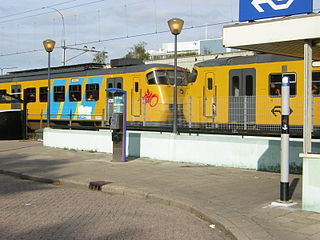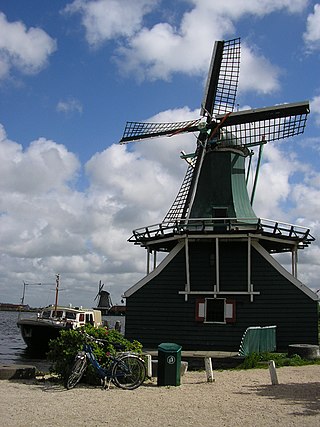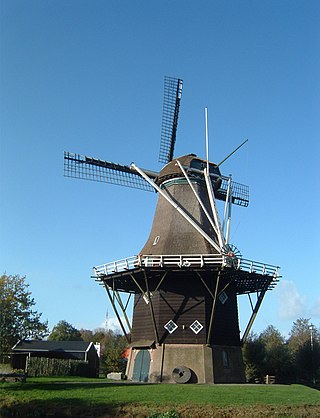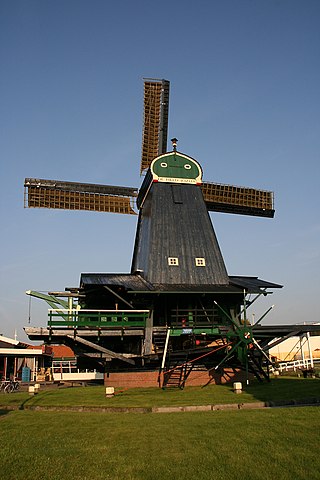
Zaanstad is a Dutch municipality in the province of North Holland, situated northwest of Amsterdam. Its main city is Zaandam. It is part of the conurbation and metropolitan area of Amsterdam. It had a population of 156,901 in 2021.

Koog aan de Zaan is a town in the Dutch province of North Holland. It is a part of the municipality of Zaanstad, and lies about 11 km northwest of Amsterdam.

The post mill is the earliest type of European windmill. Its defining feature is that the whole body of the mill that houses the machinery is mounted on a single central vertical post. The vertical post is supported by four quarter bars. These are struts that steady the central post.

Zaanse Schans is a neighbourhood of Zaandam, near Zaandijk, Netherlands. It is best known for its collection of historic windmills and wooden houses that were relocated here from the wider region north of Amsterdam for preservation. From 1961 to 1974, old buildings from all over the region known as the Zaanstreek were relocated using lowboy trailers to Zaanse Schans. Two of the windmills in Zaanse Schans are preserved on their original site where they were first constructed, and therefore do not constitute part of the relocated structures. The Zaans Museum, established in 1994, near the first Zaanse Schans windmill, is located south of the neighbourhood. This architectural reserve for Zaanse timber construction is a protected village scene because of its architectural-historical and landscape value. It developed into an international tourist destination with several million visitors every year: in 2016, there were 1.8 million, in 2017 – 2.2 million.

The Zaan is a small river in the province of North Holland in the northwestern Netherlands and the name of a district through which it runs. The river was originally a side arm of the IJ bay and travels 13.5 kilometers through the municipalities of Zaanstad and Wormerland north of Amsterdam, from West-Knollendam in the north to Zaandam in the south, where it empties into the IJ.

Zaandijk Zaanse Schans railway station, until 2016 Koog-Zaandijk railway station, is a railway station in Koog aan de Zaan and Zaandijk, both neighbourhoods of the municipality of Zaandam, Netherlands. It is also the closest railway station to Zaanse Schans. The station opened on 1 November 1869 and is located on the Den Helder–Amsterdam railway between Zaandam and Uitgeest.

De Kat is the only remaining working windmill in the world which makes paint. The mill is in the Zaanse Schans, Zaanstad.

De Huisman is a small octagonal mill at the Zaanse Schans in the Zaanstad, and currently makes mustard.

De Os is an oil windmill in the Zaanse Schans, Zaanstad.

De Zoeker is the name of an oil windmill, located in the Zaanse Schans, Zaanstad. Its purpose is to press seeds such as linseed and rapeseed into vegetable oil. It is the only oil mill still in operation, and is one of five remaining oil mills in the area.

De Vlijt, formerly known as Hoop van Zegen is a smock mill in Zuidwolde, Drenthe, which has been conserved. The mill was built in 1878 and is listed as a Rijksmonument, number 41099.

Het Jonge Schaap is the name of a wooden wind powered sawmill, located in the Zaanse Schans, in the municipality of Zaanstad.

Het Klaverblad is a small wooden saw mill, located in the Zaanse Schans, in the municipality of Zaanstad.

De Bonte Hen is the name of an oil mill, located in the Zaanse Schans, Netherlands. De Bonte Hen is the northernmost of the mills in Zaanse Schans.

The Cornwerdermolen is a smock mill in Cornwerd, Friesland, Netherlands, which has been restored to working order. The mill is listed as Rijksmonument number 39329.

Penninga's Molen or De Jonge Wester is a smock mill in Joure, Friesland, Netherlands which was built in 1900 and is working for trade. It is also used as a training mill. The mill is listed as a Rijksmonument, number 20842.

De Otter is a paltrok mill in Amsterdam, Netherlands which has been restored to working order. As all Dutch paltrok mills it is a windpowered sawmill. The mill is listed as a Rijksmonument, number 1198.

Mijn Genoegen is a paltrok mill in the Netherlands Open Air Museum in Arnhem, Gelderland, Netherlands which has been restored to working order. As are all Dutch paltrok mills, it is a wind-powered sawmill.

De Eenhoorn is a paltrok mill in Haarlem, Netherlands which has been restored to working order. As all Dutch paltrok mills it is a wind-powered sawmill. The mill is listed as a Rijksmonument, number 19872.

De Held Jozua is a paltrok mill in Zaandam, Netherlands which has been restored to working order. As all Dutch paltrok mills it is a wind-powered sawmill. The mill is listed as a Rijksmonument, number 40094.





















